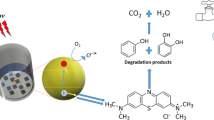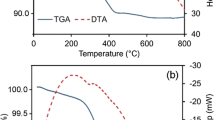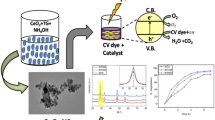Abstract
CeO2-SiO2 nanoparticles were synthesized by surfactant assisted via sol-gel process at variable pH 9, 10 and 11 by kee** constant temperature of 27 ± 2 °C. However, same method was adopted for synthesis of CeO2-SiO2 nanoparticles at higher temperature 70 ± 2 °C while pH of the solution was kept constant at 9. Prepared nanoparticles were characterized using FTIR, SEM-EDX, PL spectrophotometer, UV-Vis spectrophotometer, XRD and DLS-PSA. Influence of varying pH and temperature on particle size, band gap, oxygen vacancies and catalytic activity for degradation of chlorpyrifos pesticide was studied. It was found that increase in pH increased the particle size and band gap, however decreased the catalytic activity towards chlorpyrifos pesticide. It was observed that increase in temperature at constant pH 9 showed slight effects on above mentioned properties. CeO2-SiO2 nanoparticles prepared at pH 9 and at temperature 27 ± 2 °C were found to have lowest particle size and band gap with highest catalytic activity.
Similar content being viewed by others
References
Bootharaju MS, Pradeep T (2012) Understanding the degradation pathway of the pesticide, chlorpyrifos by noble metal nanoparticles. Langmuir 28:2671–2679
Mahdavi M, Ahmad MB, Haron MJ (2013) Synthesis, surface modification and characterisation of biocompatible magnetic iron oxide nanoparticles for biomedical applications. Molecules 18:7533–7548
Farrukh MA, Shahid M, Muneer I, Javaid S (2016) Influence of gadolinium precursor on the enhanced red shift of Gd/SnO2–TiO2 nanoparticles and catalytic activity. J Mater Sci Mater Electron 27:2994–3002
Farrukh MA, Muneer I, Butt KM (2016) Effect of dielectric constant of solvents on the particle size and bandgap of La/SnO2-TiO2 nanoparticles and their catalytic properties. J Chin Chem Soc 63:952–959
Imtiaz A, Farrukh MA, Khaleeq-ur-Rahman (2013) Micelle-assisted synthesis of Al2O3·CaO nanocatalyst:optical properties and their applications in photodegradation of 2,4,6-trinitrophenol. Sci World J 641420:11. https://doi.org/10.1155/2013/641420
Farrukh MA, Thong CK, Adnan R (2012) Preparation and characterization of zinc oxide nanoflakes using anodization method and their photodegradation activity on methylene blue. Russ J Phys Chem A 86:2041–2048
Sancheti SV, Saini C, Ambati R, Gogate PR (2018) Synthesis of ultrasound assisted nanostuctured photocatalyst (NiO supported over CeO2) and its application for photocatalytic as well as sonocatalytic dye degradation. Catal Today 300:50–57
Lin KS, Chowdhury S (2010) Synthesis, characterization, and application of 1-D ceriumoxide nanomaterials: a review. Int J Mol Sci 11:3226–3251
Rao KS, El-Hami K, Kodaki T, Matsushige K, Makino K (2005) A novel method for synthesis of silica nanoparticles. J Colloid Interface Sci 28:125–131
Rahman IA, Padavettan V (2012) Synthesis of silica nanoparticles by sol-gel: size-dependent properties, surface modification, and applications in silica-polymer nanocomposites—a review. J Nanomater 132424:15. https://doi.org/10.1155/2012/132424
Farahmandjou M, Zarinkamar M, Firoozabadi TP (2016) Synthesis of cerium oxide (CeO2) nanoparticles using simple CO-precipitation method. Rev Mex Fis 62:496–499
Harraz FA, Abdel-Salam OE, Mostafa AA, Mohamed RM, Hanaf M (2013) Rapid synthesis of titania–silica nanoparticles photocatalyst by a modified sol–gel method for cyanide degradation and heavy metals removal. J Alloys Compd 551:1–7
Benedetti F, Luches P, Spadaro MC, Gasperi G, D’Addato S, Valeri S, Boscherini F (2015) Structure and morphology of silver nanoparticles on the (111) surface of cerium oxide. J Phys Chem C 119:6024–6032
Imtiaz A, Farrukh MA (2016) Influence of CdS dopant on oxygen vacancies and Ce3+ formationin CeO2–ZnO nanocomposites: structural, optical andcatalytic properties. J Mater Sci Mater Electron 28:2788–2794
Zhang F, Cheng CH (2006) Phases in ceria–zirconia binary oxide (1x)CeO2–xZrO2 nanoparticles: the effect of particle size. J Am Ceram Soc 89:1028–1036
Mohan S, Navamani P, Jayamoorthy K, Srinivasan N (2017) Nano-silica catalyzed synthesis, solvent effect, NMR spectral and DFT studies of some imidazole derivatives. Silicon 9:817–822
Adam F, Appaturi JN, Thankappan R, Navi MAM (2010) Silica–tin nanotubes prepared from rice husk ash by sol–gel method: characterization and its photocatalytic activity. Appl Surf Sci 257:811–816
Alalm MG, Tawfik A, Ookawara S (2015) Comparison of solar TiO2 photocatalysis and solar photo-Fenton fortreatment of pesticides industry wastewater: operational conditions, kinetics, and costs. J Water Proc Eng 8:55–63
Javaid S, Farrukh MA, Muneer I, Shahid M, Khaleeq-ur-Rahman M, Umar AA (2015) Influence of optical band gap and particle size on the catalytic properties of Sm/SnO2–TiO2 nanoparticles. Superlattice Microst 82:234–247
Cochran RC (2002) Appraisal of risks from nonoccupational exposure to chlorpyrifos. Regul Toxicol Pharmacol 35:105–121
Afzaal A, Farrukh MA (2017) Zwitterionic surfactant assisted synthesis of Fe doped SnO2-SiO2 nanocomposite with enhanced photocatalytic activity under sun light. Mater Sci Eng B 223:167–177
Li M, Hu Y, Liu C, Huang J, Liu Z, Wang M, An Z (2013) Synthesis of cerium oxide particles via polyelectrolyte controlled nonclassical crystallization for catalytic application. The RSC Adv 4:992–995
Gnanam S, Rajendran V (2013) Influence of various surfactants on size, morphology, and optical properties of CeO2 nanostructures via facile hydrothermal route. J Nanoparticle 839391:6
An D, Guo Y, Zhu Y, Wang Z (2010) A green route to preparation of silica powders with rice husk ash and waste gas. Chem Eng J 162:509–514
Jiang C, Zhang Y, Wang Q, Wang T (2013) Superhydrophobic polyurethane and silica nanoparticles coating with high transparency and fluorescence. J Appl Polym Sci 129:2959–2965
Zhang J, Ge X, Wang M (2012) Facile fabrication of flower-like nanocomposite microparticles via seeded miniemulsion polymerization. Polym Chem 3:2011–2017
Sevik C, Bulutay C (2007) Theoretical study of the insulating oxides and nitrides: SiO2, GeO2, Al2O3, Si3N4, and Ge3N4. J Mater Sci 42:6555–6565
Laberty-Robert C, Long JW, Lucas EM, Pettigrew KA, Stroud RM, Doescher MS, Rolison DR (2006) Sol−gel-derived ceria nanoarchitectures: synthesis, characterization, and electrical properties. Chem Mate 18:50–58
Colis S, Bouaine A, Schmerber G (2012) High-temperature ferromagnetism in co-doped CeO2 synthesized by the coprecipitation technique. Phys Chem Chem Phys 14:7256–7263
Balestrieri M, Colis S, Gallart M, Schmerber G, Ziegler M, Gilliot P, Dinia A (2015) Photoluminescence properties of rare earth (Nd, Yb, Sm, Pr)-doped CeO2 pellets prepared by solid-state reaction. J Mater Chem C 3:7014–7021
Lim J, Yeap SP, Che HX, Low SC (2013) Characterization of magnetic nanoparticle by dynamic light scattering. Nanoscale Res Lett 8:381
Sun C, Li H, Chen L (2012) Nanostructured ceria-based materials: synthesis, properties, and applications. Energy Environ Sci 5:84785–88505
Zhu X-D, Huebner W (2001) Size-induced lattice relaxation in CeO2 nanoparticles. Appl Phys Lett 79:3512–3514
Butt KM, Farrukh MA, Muneer I (2016) Influence of lanthanum do** via hydrothermal and reflux methods on the SnO2–TiO2 nanoparticles prepared by sol–gel method and their catalytic properties. J Mater Sci Mater Electron 27:8493–8498
Zhao X, Long R, Chen Y, Chen Z (2010) Synthesis, characterization of CeO2@SiO2 nanoparticles and their oxide CMP behavior. Microelectron Eng 87:1716–1720
Lee S-H, Lu Z, Babu VS, Matijević E (2002) Chemical mechanical polishing of thermal oxide films using silica particles coated with ceria. J Mater Res 17:2744–2749
Lin J, Wu Y, Khayambashi A, Wang X, Wei Y (2018) Preparation of a novel CeO2/SiO2 adsorbent and its adsorption behavior for fluoride ion. Adsorpt Sci Technol 36:743–761
Farrukh MA, Butt KM, Chong K-K, Chang WS (2018) Photoluminescence emission behaviour on the reduced band gap of Fe do** in CeO2-SiO2 nanocomposite and photophysical properties. J Saudi Chem Soc. https://doi.org/10.1016/j.jscs.2018.10.002
Pervaiz S, Farrukh MA, Adnan R, Qureshi FA (2012) Kinetic investigation of redox reaction between vitamin C and ferric chloride hexahydrate in acidic medium. J Saudi Chem Soc 16:63–67
Acknowledgements
The corresponding author (Muhammad Akhyar Farrukh) is thankful to the Higher Education Commission (HEC) Pakistan for providing funds for the Project No. 20-3142/NRPU/R&D/HEC/14 entitled “Synthesis of iron doped CeO2-SiO2 nanocomposites for catalytic degradation of organophosphorus pesticides in water”.
Author information
Authors and Affiliations
Corresponding author
Additional information
Publisher’s Note
Springer Nature remains neutral with regard to jurisdictional claims in published maps and institutional affiliations.
Rights and permissions
About this article
Cite this article
Farrukh, M.A., Butt, K.M., Altaf, A. et al. Influence of pH and Temperature on Structural, Optical and Catalytical Investigations of CeO2-SiO2 Nanoparticles. Silicon 11, 2591–2598 (2019). https://doi.org/10.1007/s12633-018-0050-7
Received:
Accepted:
Published:
Issue Date:
DOI: https://doi.org/10.1007/s12633-018-0050-7




